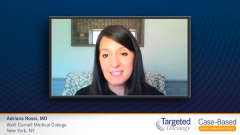
Clinical Pearls for the Management of TCR MM
Adriana Rossi, MD, provides clinical pearls on the management of triple-class refractory multiple myeloma.
Episodes in this series

Adriana Rossi, MD: I think it is challenging for those of us who do nothing but myeloma to keep up with the volume of data, the new agents, the combinations, the new therapeutic approaches. I can only imagine in a community setting, when you still need to know how to care for so many different things, it is not possible to keep track of everything. I would hope that most community physicians are able to partner with someone at an academic institution, or someone who devotes most of their time to myeloma, and have that shared—one of my patients calls it shared custody. Where you have someone who is keeping up to date and hopefully participating in clinical trials to keep a running tally. And you’d have a local oncologist to give the hands-on care to the patient. Maybe that would be one of the silver linings of COVID-19 and all the telemedicine we’ve developed, a little easier access to the academic institutions. If we can help in any way to educate and to facilitate, and to run through cases, it’s one of my favorite things.
This was a great case that offers us a lot of reminders on best practices. This was considered a patient with transplant-ineligible multiple myeloma. She received highly active triplets. Hopefully, again not detailed, but she was maintained on continuous therapy. Once you use a triplet regimen, you have a component of that triplet continued until progression or intolerable toxicity. We’ve talked about the bone health and making sure that patients, in addition to their chemotherapy regimen, have some sort of antiresorptive therapy, be it denosumab or zoledronic acid. Our practice is to dose monthly during active treatment and every 3 months during a maintenance treatment. We also want to make sure they’re being followed by dentists, specifically for that. And we want to be sure we’re monitoring patients, especially an active patient who’s on therapy should be monitored every month. This poor lady went 3 months and got herself into an awful lot of trouble. And selecting drugs; when a patient is relapsing, if it is a clinical relapse, you have to be sure you are picking a new regimen. But in the setting of a biochemical relapse, you could alter one or the other partner and try to gain more mileage out of each agent the patient receives.
Transcript edited for clarity.
Case: A 75-Year-Old Woman with Triple-Class Refractory Multiple Myeloma
Initial Presentation
- A 75-year-old woman diagnosed with multiple myeloma 5 years ago returns to the clinic with complaints of extreme fatigue, increased muscle weakness and new bone pain in her right hip, right forearm and low back. She reports that she is currently taking antibiotics for a bacterial infection, her third in the last 12 months.
- Treatment history:
- Initially treated with DRd; CR lasting 20 months
- Switched to VRd, stable disease lasting 16 months
- Subsequently switched to KPd, achieved a PR lasting 12 months
- Started selinexor; follow up at 9 months showed M protein increase by 0.5 g/dl; patient continued to feel well
- Currently, 3 months after her last visit, she returns to the clinic for follow-up
- PE: new bony tenderness appreciated on right hip, pelvis forearm and lumbar spine; bruising and mild bleeding of the gums
Clinical Workup
- Labs: Hb 6.2 g/dL, calcium 8.4 mg/dL, LDH 160 U/L, creatinine 2.1 mg/dL, albumin 2.7 g/dL, b2 microgloblulin 4.9 mcg/mL, serum M-protein 4.2 g/dL, lambda free light chains 4.1 mg/dL
- HBV negative
- Skeletal survey and MRI revealed lytic bone lesions in the left hip, pelvis and L2 vertebrae and lytic lesions as well as a hairline fracture in the distal radius of the right arm
- Bone marrow shows 62% plasma cells IgG k
- FISH: t(11;14) at diagnosis; new del(17p)
- Diagnosis: R-ISS stage II MM
- ECOG 1
Treatment
- Initiated treatment with belantamab mafodotin









































